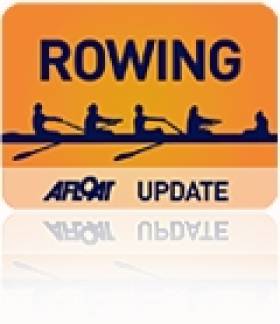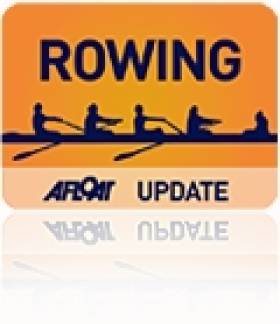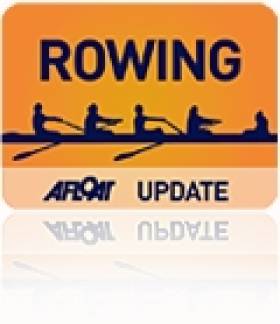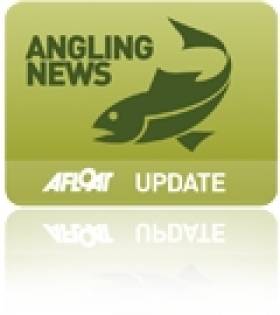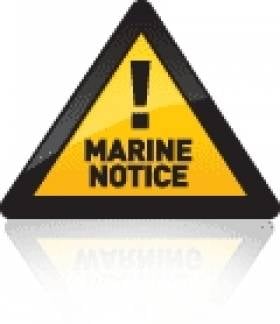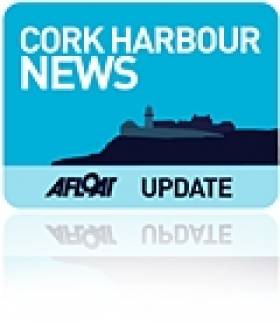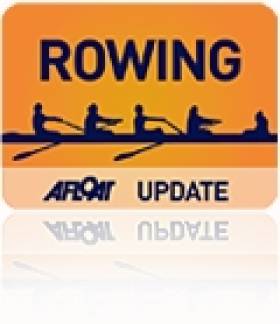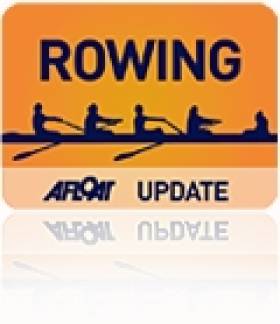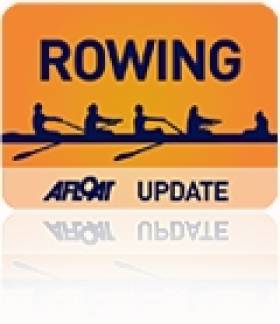Displaying items by tag: Cork
#Rowing: UCC’s Andy Harrington and David O’Leary won the men’s senior pairs title at the Irish Rowing Championships this morning. The young crew flew away from their opponents in the third quarter and won well from NUIG.
Trinity had a fine win in the men’s intermediate eights, finishing well under pressure from UCD, while Portora’s win in the men’s junior coxed four was even closer. They were caught by St Joseph’s of Galway coming up to the line, but pushed again and won – by .16 of a second.
The women’s races were won by clearer margins. Dervla Forde took the junior single sculls, Skibbereen’s Orla Hayes and Aoife Casey the intermediate double and Commercial the novice eights, all in impressive fashion.
Cathal Merz also led down the course to win the men’s club single sculls.
Irish Rowing Championships, National Rowing Centre, Cork (Day Two, Selected Results)
Men
Eight – Intermediate: 1 Trinity 5:46.51, 2 UCD A 5:49.27, 3 Queen’s 6:08.61.
Four – Junior, coxed: 1 Portora 6:36.84, 2 St Joseph’s 6:37.0, 3 Athlunkard 6:45.18.
Pair – Senior: 1 UCC 7:03.18, 2 NUIG 7:10.16, 3 Carlow 7:12.51.
Sculling, Single – Club: 1 Shandon (C Merz) 7:42.94, 2 Clonmel (D Lynch) 7:44.96, 3 Lee (D Larkin) 7:45.94.
Women
Eight – Novice: 1 Commercial 6:59.55, 2 Queen’s 7:13.67, 3 Trinity 7:13.67.
Sculling, Double – Intermediate: 1 Skibbereen 7:36.62, 2 St Michael’s 7:45.87, 3 Belfast BC 7:48.80.
Single – Junior: 1 Cork (D Forde) 8:07.98, 2 Skibbereen (E Hegarty) 8:18.01, 3 Offaly (A Mooney) 8:21.91.
#Rowing: UCC’s young crew did not make it through to the main draw at Henley Royal Regatta. In the qualification races tonight they finished 12th of the 25 non-qualifiers for the Prince Albert for student coxed fours, setting a time of seven minutes and exactly 36 seconds. The Belfast Rowing Club crew which had hoped to make it through in the Wyfold for club fours also lost out. Separate to the qualifiers, Alan Campbell was listed as withdrawing from the draw from the Diamond Sculls.
Henley Royal Regatta, Qualification Races (Irish interest)
Wyfold (Four, Club): Belfast RC 7 mins 41.3, did not qualify
Prince Albert (Coxed Four, Student): UCC 7:36, did not qualify
Ireland Senior Team Named For Home International Regatta
#ROWING: The Ireland senior team for the Home International Regatta in Strathclyde in Scotland on July 25th has been named. Justin Ryan, who was a senior Ireland international in 2013, will compete in the lightweight single sculls. The selection was based on performances at Cork Regatta, but the times used were from the manual system, as there were problems with the automatic system. The athlete levy will be €400.
| SENIOR MEN |
|---|
| The following Senior Men have been selected to compete for Rowing Ireland at the |
| Home International |
| Regatta 2015 |
| SENIOR |
| MEN SCULLING |
| 1 |
| x |
| Luke Keating |
| Carlow RC |
| Lwt 1 |
| x |
| Justin Ryan Skibbereen RC |
| 2x |
| Fionnan Groome Commercial RC |
| Ronan Allen Garda BC |
| Lwt 2x |
| Declan O’Connor St Michaels RC |
| Raymond O’Mahony Waterford BC |
| 4x |
| Justin Ryan Skibbereen RC |
| Declan O’Connor St Michaels RC |
| Luke Keating Carlow RC |
| Fionnan Groome Commercial RC |
| SENIOR |
| MEN SWEEP |
| 2 |
| - |
| Neil Gahan Commercial RC |
| Colm Dowling Commercial RC |
| Lwt 2 |
| - |
| TBD |
| 4 |
| - |
| Max Murphy UCD BC |
| Niall Farrell UCD BC |
| Ken McCarthy Skibbereen RC |
| Murray Connolly Skibbereen RC |
| 4+ |
| Andy Harrington UCC RC |
| Alex O’Riordan UCC RC |
| David O’Leary UCC RC |
| Sean O’Sullivan UCC RC |
| Gavin Connolly - Cox Commercial RC |
| 8+ |
| Neil Gahan Commercial RC |
| Colm Dowling Commercial RC |
| Max Murphy UCD BC |
| Niall Farrell UCD BC |
| Ken McCarthy Skibbereen RC |
| Murray Connolly Skibbereen RC |
| Andy Harrington UCC RC |
| Alex O’Riordan UCC RC |
| Gavin Connolly - Cox Commercial RC |
| The crews listed above are not listed in seat order in t |
| he boats |
| Page 2 of 3 |
| SENIOR WOMEN |
| The following Senior Women have been selected to compete for Rowing Ireland at |
| the Home International |
| Regatta 2015 |
| SENIOR |
| WOMEN SCULLING |
| 1 |
| x |
| Julia Vascotto Castleconnell |
| BC |
| Lwt 1 |
| x |
| Sarah Quinn Belfast BC |
| 2x |
| Olivia Blundell Belfast BC |
| Chloe Deyermond MCB RC |
| Lwt 2x |
| Phoebe Mulligan Belfast BC |
| Kirstie Turner Belfast BC |
| 4x |
| Sarah Quinn Belfast BC |
| Phoebe Mulligan Belfast BC |
| Kirstie Turner Belfast BC |
| Julia Vascotto Castleconnell |
| BC |
| The crews listed above are not listed in seat order in t |
| he boats |
| SENIOR |
| WOMEN SWEEP |
| 2 |
| - |
| Michelle Lonergan Shannon RC |
| Helen Ryan Shannon RC |
| Lwt 2 |
| - |
| TBD |
| 4 |
| - |
| Aoife Gilligan Shannon RC |
| Karen Joy Shannon RC |
| Dineka Maguire QUBLBC |
| Aine De Baroid QUBLBC |
| 4+ |
| Anne O’Leary Commercial RC |
| Edel Garry Commercial RC |
| Martina Bracken Commercial RC |
| Emma Feerick Neptune RC |
| Shauna Fitzsimons – Cox Commercial RC |
| 8+ |
| Michelle Lonergan Shannon RC |
| Helen Ryan Shannon RC |
| Anne O’Leary Commercial RC |
| Edel Garry Commercial RC |
| Aoife Gilligan Shannon RC |
| Karen Joy Shannon RC |
| Martina Bracken Commercial RC |
| Emma Feerick Neptune RC |
| Shauna Fitzsimons - Cox Commercial RC |
| The crews listed above are not listed in seat order |
Fish Kill Investigated At Carrigadrohid Reservoir
#FishKill - Inland Fisheries Ireland (IFI) and Cork County Council are investigating fish mortalities at Carrigadrohid Reservoir in Co Cork following the discovery of small numbers of bream and rudd.
As of 14 June no cause has been identified, but water and fish samples were being collected for further analysis at the popular coarse angling spot.
IFI has a 24-hour confidential hotline number to enable members of the public to report incidents at 1890 34 74 24 or 1890 FISH 24.
This phone line is designed to encourage the reporting of incidents of illegal fishing, water pollution and invasive species. For more information visit www.fisheriesireland.ie.
Marine Notice: Geophysical Survey In Celtic Sea
#MarineNotice - The latest Marine Notice from the Department of Transport, Tourism and Sport (DTTAS) advises that Osiris Projects were last week scheduled to begin marine survey operations off the south coast in the Celtic Sea.
The marine surveys will extend from the shoreline at two locations in Co Cork across the sea to the shoreline at two locations in northern France.
The survey was set to start on Monday 1 June 2015 to last for approximately three weeks, weather permitting. The survey will be conducted by the MV Proteus (Callsign 2HBL7).
The marine surveys will extend from the shoreline at Ballinwilling Strand (main route) and Ballycroneen Beach (alternative route), across the Celtic Sea, passing the Isles of Scilly, to the French coast west of Roscoff at Moguériec (main route) and Pontusval (alternative route).
The corridor width for each landing will be 250 metres from the high water mark to the 10-metre contour, then the corridor will widen to 500m as the route moves to France.
The survey vessel may be found running both along the corridor, and in the general vicinity of the survey corridor. The survey areas are small boxes which are shown in the detail plan HERE.
Survey operations will involve towing survey equipment on and below the water surface, up to 300m behind the vessel. All vessels, particularly those engaged in fishing, are requested to give the MV Proteus and her towed equipment a wide berth and keep a sharp lookout in the relevant areas.
Full co-ordinates for the relevant work areas are detailed in Marine Notice No 25 of 2015, a PDF of which is available to read or download HERE.
Superyacht 'Air' Returns to Cork Harbour & Kinsale
#superyachtvisit – Return visitor to Ireland, the 81-metre long super motor yacht 'AIR' cut a dramatic pose as an early season caller to Cork Harbour yesterday. As Afloat reported previously, this black hulled Dutch-built Feadship was launched in March in 2011 and called to the Irish South coast in 2012. The yacht is available for charter at the reported rate of €750,000 per week. Onboard luxury inlcudes a helicopter pad and 102-inch pop-up movie screen.
The largest yacht ever to be built at the Koninklijke De Vries yard, AIR has a sleek and elegant exterior with modern lines, it has a matte black steel hull, and an aluminium superstructure. She measures 265.7 feet in length and has a beam of nearly 39 feet.
Extremely spacious, the vessel can accommodate 12 guests in 7 roomy staterooms including an impressive split level owner's suite, two guest cabins on the upper deck, one cabin on the main deck, and three on the lower deck. The owners' observation lounge offers a breathtaking view over the eight-meter long pool on the main deck's forward area.
#Subsea - The Irish Times has more details on the new transatlantic subsea internet cable Hibernia Express, work on which got underway this past March.
Clearance and pre-laying work continued this month in the Celtic Sea to prepare for the arrival of the 4,600km fibre optic cable in Cork Harbour in the coming weeks.
Once connected to the new Cork Internet Exchange (CIX), it will be the first modern telecommunications cable of its kind to link North America and Europe in well over a decade.
And its speed and capacity – offering the lowest latency between New York and London – will be a boon for businesses that depend on the fastest possible and most robust data connections.
Combined with the shorter Ireland-France Subsea Cable, it's also set to make Cork a leading global internet switching centre, eliminating the need for Ireland's internet traffic to go through the UK before the rest of the world, as TechCentral reports.
#ROWING: Christian Brothers College and Cork Boat Club today signed a joint Memorandum of Understanding at the College in a signing ceremony which moves the longstanding close relationship between the College and the rowing club to a more formal basis.
This follows the recent decision by Christians Brothers College Board of Management to invest in rowing boats and equipment to enhance the facilities available to its students, and to work closely with Cork Boat Club to take advantage of the excellent coaching and training facilities at the club.
The chief executive of Rowing Ireland, Hamish Adams, attended the signing of the agreement between Christian Brothers College and Cork Boat Club and said “Rowing Ireland is delighted to endorse this joint initiative between Cork Boat Club and Christian Brothers College. Such a positive relationship advancing Schools and Club rowing through one of the most successful Clubs in the country is very innovative and encouraging for the future of our sport.”
Dr. Larry Jordan, Principal of Christian Brothers College, added: “We are delighted to work closely with Cork Boat Club to avail of the excellent equipment, facilities and coaching at the club. Their ethos and ours are very complimentary and the relationship has allowed the college to develop rowing as a sport, as a result of which the College is already competing well at schools competitions both in the UK and Ireland. Many of our past rowers have gone on to row at university level and at the highest levels of rowing both nationally and internationally and are sources of great pride for the College.”
Karen McCarthy, Captain of Cork Boat Club, said: “We are very focused on developing schools rowing, and in fact supported six different schools at the recent Schools Rowing Championships with boats and coaches. The relationship with Christian Brothers College has been a very positive one and we are delighted to now work more closely with the College to develop deep rowing talent in the coming months and years.”
Cork Boat Club is the largest rowing club in Cork City and in 2014 won seven national rowing championships. In 2014 it also had the distinction of being the club with the most rowers selected to represent Ireland in various international competitions.
Great Day for Enniskillen at Irish Schools Regatta
#ROWING: Two schools from Enniskillen took some of the major honours on offer at the Irish Schools Regatta at O’Brien’s Bridge. Enniskillen Collegiate won the women’s under-23 eights, fours and pairs, and Portora Royal School won the under-23 eights and pairs. Presentation Brothers College, Cork, took the men’s coxed fours. Waterpark College’s Andrew Goff was the top single sculler, and Sarah Murphy of Gaelcholáiste Luimnigh the top women’s sculler.
Irish Schools Regatta 2015, O’Brien’s Bridge, Selected Results
Men
Eight – Under-23: 1 Portora, 2 St Joseph’s, 3 Presentation, Cork. Junior 16: 1 St Joseph’s, 2 Col Iognáid, 3 Presentation, Cork. Jun 15: 1 St Joseph’s, 2 Pres, Cork, 3 Portora.
Four – Under-23, coxed: 1 Pres, Cork, 2 St Joseph’s, 3 CBS, Cork. Jun 16: 1 Portora, 2 Col Iognáid, 3 St Joseph’s B. Junior 15, coxed: 1 St Joseph’s A, 2 Portora, 3 Presentation Cork.
Pair – Under-23: 1 Portora A, 2 St Joseph’s B, 3 Ardscoil A.
Sculling
Quadruple – Under-23: 1 Schull CS, 2 Methody, 3 CBC, Cork. Junior 16, coxed: 1 Ardscoil A, 2 Methody, 3 Killorglin. Jun 15, coxed: 1 CBC Cork A, 2 CAI, 3 Methody.
Double – Under-23: 1 Schull CS A, 2 Marist, 3 Summerhill. Junior 16: 1 Rochestown, 2 Methody, 3 Pres, Carlow. Jun 15: 1 St Mary’s, Carlow, 2 CBC, Cork, 3 Castleknock.
Single – Under-23 (Final One, Timed): 1 Waterpark (A Goff), 2 St Munchin’s (Carmody), 3 Rochestown (Larkin). (Final Two, Timed): Portora (Murray). Jun 16: 1 Castleknock (Meehan), 2 Rochestown (Larkin), 3 Ardscoil Dub (Lynch). Jun 15 – Final One: 1 St Mary’s, Carlow (J Keating), 2 Carrigaline CC (S O’Neill), 3 CBC (T Murphy). Final Two: Ardscoil (O’Byrne).
Women
Eight – Under-23: 1 Enniskillen, 2 Laurel Hill, 3 Mount Lourdes. Jun 16: 1 Col Iognáid, 2 Methody, 3 Laurel Hill. Jun 15: 1 Col Iognáid, 2 Enniskillen
Four – Under-23: 1 Enniskillen, 2 Mount Lourdes. Jun 16, coxed: 1 Col Iognáid B, 2 Enniskillen, 3 Col Iognáid A. Jun 15, coxed: 1 Col Iognaid, 2 Mount Lourdes.
Pair – Under-23: 1 Enniskillen, 2 Laurel Hill B, 3 Laurel Hill A.
Sculling
Quadruple – Under-23: 1 St Leo’s, 2 Loreto, Fermoy A, 3 Loreto, Fermoy B. Junior 16, coxed: 1 Gaelcholáiste Cheatharlach, 2 Regina Mundi, 3 St Leo’s. Jun 15: 1 Loreto, Fermoy A, 2 Christ the King, Cork, 3 St Brigid’s A.
Double – Under 23 (Final One, Timed): 1 St Angela’s, Cork, 2 Methody, 3 Ursuline, Sligo. Final Two, timed: Sacred Heart. Final Three, timed: St Leo’s B. Jun 16: St Dominic’s, 2 Sacred Heart, 3 Christ the King A. Jun 15: 1 Regina Mundi, 2 Loreto, Fermoy, 3 St Louis.
Single – Under-23: 1 Gaelcholáiste Luimnigh (S Murphy), 2 Christ the King (Cummins), 3 Methody (Deyermond). Junior 16: Scoil Mhuire (Synnott), 2 Loreto Fermoy (O’Sullivan). Jun 15 (Final One): Loreto, Fermoy (Murphy). Final Two: Loreto (McGirr).
Eights Wins for Galway Boys at Irish Schools Regatta
#Rowing: St Joseph’s of Galway won both the junior 16 and junior 15 boys’ eights at the Irish Schools Rowing Regatta at O’Brien’s Bridge. Another Galway school, Coláiste Iognáid, took the girls’ junior 15 eight. Presentation of Cork were the fastest crew in the men’s under-23 coxed four. There was a good spread of wins through the island of Ireland.
Irish Schools Regatta 2015, O’Brien’s Bridge, Selected Results
Men
Eight – Junior 16: 1 St Joseph’s, 2 Col Iognáid, 3 Presentation, Cork. Jun 15: 1 St Joseph’s, 2 Pres, Cork, 3 Portora.
Four – Under-23, coxed: 1 Pres, Cork, 2 St Joseph’s, 3 CBS, Cork. Junior 15, coxed: 1 St Joseph’s A, 2 Portora, 3 Presentation Cork.
Pair – Under-23: 1 Portora A, 2 St Joseph’s B, 3 Ardscoil A.
Sculling
Quadruple – Junior 16, coxed: 1 Ardscoil A, 2 Methody, 3 Killorglin. Jun 15, coxed: 1 CBC Cork A, 2 CAI, 3 Methody.
Double – Under-23: Schull CS A, 2 Marist, 3 Summerhill. Junior 16: 1 Rochestown, 2 Methody, 3 Pres, Carlow. Jun 15: 1 St Mary’s, Carlow, 2 CBC, Cork, 3 Castleknock.
Single – Under-23 (Final One, Timed): 1 Waterpark (Goff), 2 St Munchin’s (Carmody), 3 Rochestown (Larkin). (Final Two, Timed): Portora (Murray).
Women
Eight – Junior 15: 1 Col Iognáid, 2 Enniskillen
Four – Under-23: 1 Enniskillen, 2 Mount Lourdes. Jun 16, coxed: 1 Col Iognáid B, 2 Enniskillen, 3 Col Iognáid A. Jun 15, coxed: 1 Col Iognaid, 2 Mount Lourdes.
Pair – Under-23: 1 Enniskillen, 2 Laurel Hill B, 3 Laurel Hill A.
Sculling
Quadruple – Junior 16, coxed: 1 Gaelcholáiste Cheatharlach, 2 Regina Mundi, 3 St Leo’s.
Double – Under 23 (Final One, Timed): 1 St Angela’s, Cork, 2 Methody, 3 Ursuline, Sligo. Final Two, timed: Sacred Heart. Final Three, timed: St Leo’s B. Jun 16: St Dominic’s, 2 Sacred Heart, 3 Christ the King A.
Single – Under-23: 1 Gael Lmk (Murphy), 2 Christ the King (Cummins), 3 Methody (Deyermond). Jun 15 (Final One): Loreto, Fermoy (Murphy). Final Two: Loreto (McGirr).


























